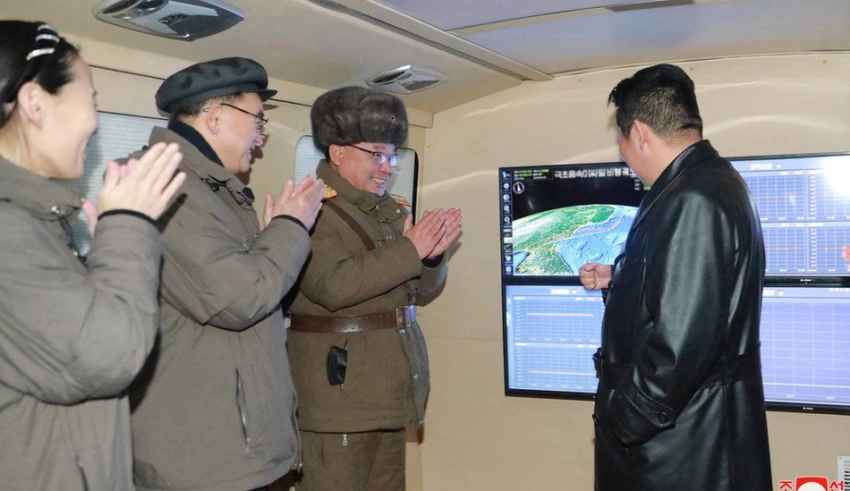
It appears that North Korea conducted its second successful test flight of a hypersonic missile on Thursday, days after the event, the country’s leader Kim Jong Un vowed to the idea of bolstering his military forces despite pandemic-related difficulties, meaning that the North part of Korea will press ahead with plans to modernize its nuclear and missile arsenals rather than return to disarmament talks anytime soon, in addition, the North’s advancing nuclear arsenal is the core of Kim’s rule, and he’s called it multiple times “a powerful treasured sword” that thwarts potential U.S. aggressions, as the fact that, during his 10-year rule, he’s conducted an unusually large number of weapons tests to acquire the ability to launch nuclear strikes on the American mainland shows.
Furthermore, the official Korean Central News Agency said the Central Committee of the ruling Workers’ Party expressed “great satisfaction” at the results of the missile test, which was observed by leading weapons officials.
When referring to a hypersonic missile, we must understand that they can theoretically fly as fast as 20 times the speed of sound and can be very maneuverable in flight, making them almost impossible to shoot down, according to experts, nowadays, only two countries, Russia and China, are thought to have available deployable hypersonic missiles.
As a matter of fact, in December 2019, Russia said its hypersonic missile system, known as Avangard, had entered service and, in a speech to the Russian Parliament in 2018, President Vladimir Putin referred to the Avangard system as “practically invulnerable” to Western air defenses, moreover, in August, China tested a missile and according to the US military “They launched a long-range missile,” of course, China denied all the allegations, saying what the US called the test of a hypersonic weapon what was a “routine spacecraft experiment.”
On the other hand, according to a report last year from the Arms Control Association (ACA) in Washington, DC, the United States is currently and actively working on eight types of hypersonic weapons and the military’s Defense Advanced Research Project Agency said last fall it had successfully tested a hypersonic weapon.
Furthermore, among scientists, there is some argument that this makes hypersonic a destabilizing first-strike weapon, “Each side may believe it has to strike first, and strike fast, to achieve its objectives. This dynamic often referred to as crisis instability, could provoke the start of a conflict even if neither party to the crisis initially planned to strike first,” analysts Kelley Sayler and Amy Woolf wrote in a November report for the US Congressional Research Service.
When it comes to North Korea, the country is showing that it will not ease off claims that it is a victim of Western powers anytime soon and must develop military deterrents to what it sees as possible aggressive moves by foes like the US and South Korea, “Rather than expressing willingness for denuclearization talks or interest in an end-of-war declaration, North Korea is signaling that neither the omicron variant nor domestic food shortages will stop its aggressive missile development,” said Leif-Eric Easley, associate professor of international studies at Ewha Womans University in Seoul.
Hypersonic weapons could pose crucial challenges to missile defense systems because of their speed and maneuverability, however, it’s unclear whether and how soon North Korea could manufacture such a high-tech missile, but it was among a wish-list of sophisticated military assets that Kim disclosed early last year, along with a multi-warhead missile, spy satellites, solid-fueled long-range missiles and underwater-launched nuclear missiles.
It is obvious that these “strategic” missiles are being developed to deliver nuclear weapons, more precisely Hypersonic weapons are considered the next generation of arms that aim to rob enemies of reaction time and traditional defeat mechanisms.
When it comes to the international response UN Secretary-General Antonio Guterres said he was “very concerned” by the latest launch and the European Union urged the secretive state to “respond constructively” to US readiness for diplomacy.
Japan also condemned the missile test, saying it undermines peace and security in the region, according to Japanese chief cabinet secretary Hirokazu Matsuno.
President Joe Biden’s administration has said it is open to talking to North Korea, as The U.S. military called it a ballistic missile launch that “highlights the destabilizing impact of North Korea’s illicit weapons program,” in addition, U.S.-led diplomacy on North Korea’s nuclear program remains stalled since 2019 due to disputes over international sanctions on the North, since then, the Biden administration has repeatedly called for resuming the nuclear diplomacy “anywhere and at any time” without preconditions, but North Korea has argued the U.S. must first withdraw its hostility against it before any talks can restart.
China, for its part, called for dialogue and said that “all parties concerned should keep in mind the big picture and be cautious with their words and actions.”
On the other hand Pyongyang has said American overtures are empty rhetoric without more substantive changes to “hostile policies” such as military drills and sanctions.
References:
Kim backs “military muscle” as he watches hypersonic missile test, available at:
https://www.aljazeera.com/news/2022/1/12/kim-hypersonic-missile
N.Korea’s Kim calls for more “military muscle” after watching hypersonic missile test, available at:
North Korea’s leader Kim wants more military muscle, available at:
North Korea claims to be testing the world’s most advanced weapon. Experts are doubtful, available at:
https://edition.cnn.com/2022/01/06/asia/north-korea-missile-test-explained-intl-hnk-ml/index.html
NKorea claims second successful test of a hypersonic missile, available at:
By The European Institute for International Law and International Relations.














